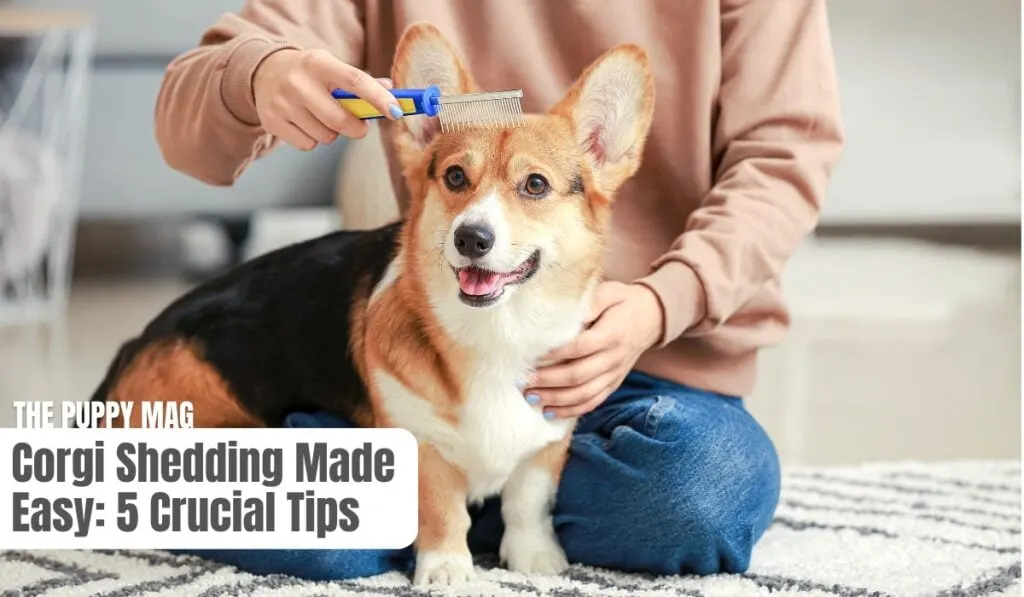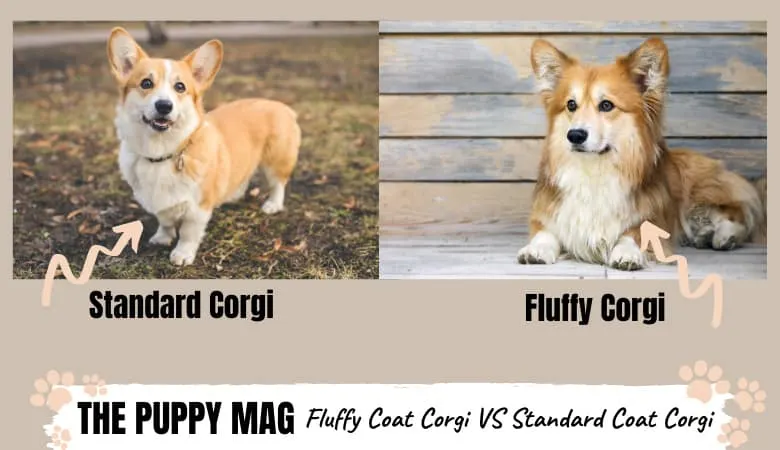Corgis may be small, but don’t underestimate their ability to shed big!
After years of sweeping up, I decided to learn a thing or two about managing shedding, and thankfully, the tips I picked up worked!
In this article, I’ll show you the best way to deal with your corgis shedding.

Table of Contents
How Much Do Corgis Shed?
Corgis are year-round shedders. You can expect your corgi to drop hair on a daily basis throughout the year. This is followed by two bigger coat blowouts in spring and sometimes before winter.
As warmer weather approaches in springtime you can expect your corgi to shed most of her undercoat to make way for the warmer weather. This improves her ability to expel heat and remain cool.
Extra shedding also happens as winter approaches. As the temperature starts to drop, your corgi’s coat will start growing rapidly in order to develop a thick undercoat for winter. Surprisingly enough, quick growth also incurs a lot of shedding of old hair.
When Do Corgis Start Shedding?
Corgis typically start shedding once they have their adult coat, which usually comes between 6-10 months of age. Before this, their puppy coat will hold on to most of its fluffy hair.
As your Corgi gets closer to the 6-8 month mark, you might find that their coat becomes patchy and clumps of hair come out… This is for the most part completely normal and marks the transition from their puppy coat to adult coat.
Once they have their adult coat, regular shedding will commence.
5 Crucial Tips to Handle Corgi Shedding
I can assure you if you take on board these tips, you will be able to deal with your corgi’s shedding easily. These are the same principles that I use for Siberian Huskies (who are notoriously big shedders).
1. Correct brushing routine & brushes!
The most crucial part of successfully dealing with corgi hair involves sticking to an appropriate brushing routine and using the correct brushes!
When it comes to brushing, little and often is the only way to do it. Forgetting to brush, then trying to compensate with one big brush for an hour straight, just doesn’t work.
Aim to brush your corgi 3-5 times per week, for just 15 minutes each time. This will keep on top of shedding and maintain her coat much more effectively than a 1-hour brush, once a week.
Use an undercoat rake for the first 10 minutes for the purpose of de-shedding, followed by a slicker brush for the last 5 minutes for clearing out the topcoat. This routine, with these brushes, is simple and very effective.
- Why we AVOID the FURminator for Corgis
2. Bathe your corgi correctly
It’s true that bathing can help with shedding, but there’s a fine line between bathing and over-bathing. Over-bathing will end up being detrimental to your corgi’s coat and will actually increase shedding.
Once every two months is a good amount to bathe your corgi. I know, it’s so tempting to bathe her more than this but doing so will only work against you.
The reason infrequent bathing is preferred is to preserve her natural oils found on the skin and coat. Shampoo cleans by using various ingredients that essentially strip away these important oils.
If this happens too much, too often, it can lead to dry skin and damaged hair. This increases how brittle her coat is, and makes her hair prone to fall out.
By keeping her baths to no more than once every couple of months you will find a good balance between keeping her clean and helping her shedding without damaging her coat.
And of course, it’s super important to only ever use a natural-ingredient dog shampoo. Regular dog shampoo contains harsh chemicals, detergents, and parabens that are simply terrible for her skin and coat.
3. Ensure a healthy diet
The overall health of your corgi’s skin and coat is directly impacted by the quality of her diet and her nutrition.
Malnutrition is actually one of the biggest contributors to excessive shedding. Yet it’s often overlooked.
Without a high-quality diet where she receives proper nutrients, her skin and coat will pay the price.
Corgis are high-energy working dogs and therefore thrive best on a high protein and fat diet with low carbohydrates. This macronutrient breakdown best mimics that of a wild diet, which is known to digest the most efficiently.
Always opt for a premium brand that tailors its formula towards small breeds. This usually means the kibble is made smaller to benefit the stomach size of a small breed. Our top pick: Wellness Complete Health Small Breed Formula.
If your corgi has a sensitive stomach, try opting for a kibble that uses salmon, duck, turkey, or other fish as the main protein source. This avoids chicken, beef, lamb, and pork which are all common allergens.
Not only that but salmon will contain a high amount of essential fatty acids like Omega 3, Omega 6, and DHA. These fatty acids contribute to overall skin and coat health.
4. Never shave or cut her coat extensively
I’m still surprised how many owners shave their corgi’s coat.
A very light trimming will likely do no harm, but shaving or extensive cutting of the hair is a big no-no!
Double-coated breeds need both their undercoat and their topcoat to perform specific roles.
Shaving in an attempt to reduce shedding could potentially ruin the coat for years to come.
This is because the undercoat significantly outgrows the topcoat when shaved together. This leads to thick matting that can eventually lead to skin problems, and overheating issues for your corgi.
I know, you probably already knew this, but I had to mention it because it’s still happening all the time.
5. Provide sufficient exercise
This one is a little like ensuring her diet and nutrition is spot on. This is because overall health has a big impact on the health of her skin and coat.
Corgis are little balls of energy and despite their size, need a lot of exercise. A corgi should receive at least a solid hour of exercise per day. Ideally split up between the morning and evening.
By providing sufficient exercise you will keep her body strong and fit which will inevitably lead to improved health.
Plus, the more time you spend outside, the more hair that doesn’t end up on your floors! It’s a small win, be we’ll take it!
Do Fluffy Corgis Shed More Than Standard Corgis?
Fluffy corgis are those that have inherited the recessive coat mutation gene, and as a result, have a significantly longer coat than the standard corgi has.
You may be inclined to think that fluffy corgis will shed more than standard corgis, but this likely isn’t the case. It will mainly just be a difference between the length of hair falling on the floor, as opposed to the amount.
Due to the fluffy corgi having longer hair, it may just seem like they shed more, but in fact, it’s likely going to be more or less the same.

Corgi Shedding: FAQ’s
Let’s run through some of the most frequently asked questions I receive about corgi shedding. I will try to give the most concise answer possible.
How much do corgis shed?
Corgi’s shed quite a lot but then again they are only small dogs, so, in reality, shedding can be easily managed. Compared to a large double-coated breed, corgis don’t really shed that much. Ultimately the answer to this question depends on how you compare the shedding.
When do corgis blow their coat?
Corgis typically “blow their coat” twice a year in the spring and just before winter. Not all corgis actually blow their coat and it depends mostly on the weather, their age, and health.
How do I stop my corgi from shedding?
You can’t. There is no way you can stop a corgi from shedding. All you can do is better manage shedding to reduce the amount of hair that ends up on your floors and clothes. A strict brushing routine, not over-bathing her, feeding a quality diet, and providing sufficient exercise should do the trick.
Which kind of corgi sheds the most?
Both the Pembroke and the Cardigan Welsh corgi shed a lot. They do have slightly varying lengths of coat, but it’s negligible. Both kinds of corgi will shed all year round with distinct blowouts at the beginning of summer and winter. They both have double coats.
Which dog brush is best for a corgi?
The two best brushes for a corgi would have to be the Furminator Undercoat Rake and the Hertzko Slicker Brush. These two brushes combined provide the ultimate all-around brushing experience. The undercoat rake serves the purpose of dead hair removal, and the slicker brush combs through the topcoat making it smooth and clean.
Are corgis hypoallergenic?
No, corgis are not hypoallergenic and are therefore not a wise choice for someone allergic to pets. It’s not the hair itself that causes the problems. It’s the “dander” which is basically a dog’s version of dandruff. Whenever dogs shed, they release dander into the air and all-around your home and on your clothes.
What’s the best shampoo to use for shedding?
The only shampoo you should ever use is a high-quality natural-ingredient dog shampoo. Unfortunately, regular dog shampoo, human shampoo, and special “de-shedding” shampoos are often filled with harsh chemicals, detergent, alcohol, and parabens. These shampoos may initially remove hair, but in the long run, will cause bigger problems with her skin and coat. Ultimately leading to more shedding.
Does stress make corgis shed more?
Yes, higher stress levels and anxiety will certainly lead to increased shedding. This is actually the same for all dogs (even humans experience the same with hair loss). Ensure your corgi’s needs are met and that she lives a healthy, happy, stress-free life. This will allow her coat to be as strong as it’s going to be.
Will my corgi shed more in summer?
Typically, yes. Due to the warmer weather and the constant need to remain as cool as possible she will continuously shed her undercoat while necessary.
Why do corgis shed so much?
Double-coated breeds are either northern breeds or working breeds and both types were bred spending a lot of time outside. Naturally, over hundreds (sometimes thousands), these breeds have developed a double-coat. This provides them greater protection from the outside elements. Having a double coat keeps them warm in winter, and they are able to shed their undercoat to keep cool in summer.
Why are corgis so awesome?
We haven’t discovered the secret to their awesomeness. All we know is that the almighty corgi continues to get cuter and more adorable as the years go by.
Last Thoughts
The best way you can manage your corgi’s shedding is by having a solid brushing routine, not over-bathing her, giving her adequate exercise, and ensuring her diet is top-quality.
You will never be able to stop your corgi from shedding altogether. You can just learn what works best for your corgi, and develop a routine that effectively manages it.
Popular Corgi Articles:
● Can Corgis Get Cold? Best Winter Practices
● Why Is My Corgi Shaking?
● Why Jumping Is Very Bad For Corgis
View more Corgi articles >>
